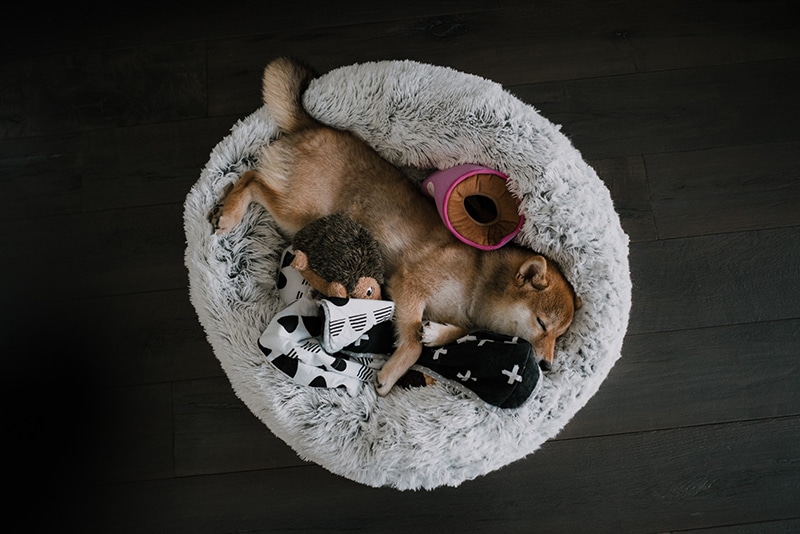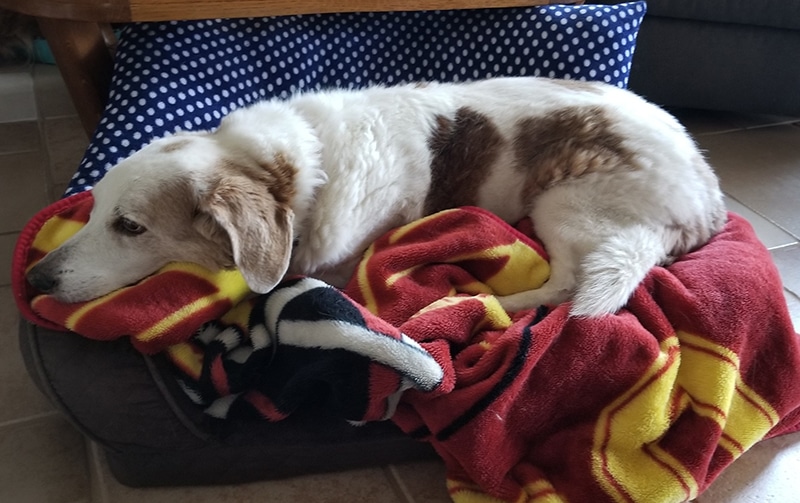The life of your dog’s bed depends on the type of bed you get as well as what kind of dog you have. For example, if you buy a cheap dog bed, it will not last long no matter how nice your dog treats it.
But even if you buy a high-quality bed, you will eventually need a new one because they get worn out over time, just like your own bed. Dog beds are usually not made to last a lifetime but if you get a sturdy bed made with all the best materials and handcrafting, you can get one that lasts a year or two. Of course, this depends on the material and how rough your dog is on his bed.
You will also need to get the right type of bed for your dog. If he is a chewer or digger, he will need a sturdy bed that is almost indestructible. An older dog needs orthopedic support. Also, getting a bed that is easy to clean is important to the bed’s lifespan.
We go into more detail about how long a dog bed lasts, signs that you need a new one, what to do with the old one, and how to make your next bed last longer.
10 signs your dog needs a new bed

Some signs to look for include wear and tear, he has outgrown his bed, or he may have chewed his bed into pieces. Also, your pup may need a different type of bed for health reasons. He certainly needs a new one if his is so dirty that he will not even use it anymore. We went into details below.
Your dog needs a new one if his bed is worn out, he has outgrown his, he is a chewer, or has separation anxiety. You should also get a new one if his is extremely dirty, smells horrible, or has an infestation of bugs. If your pup has different health needs, you need a new bed.
The Bed is Worn Out
The bed is getting ragged or worn out just from use. Replacing a bed that is worn out is not just for aesthetics. The torn and tattered bedding can become a health hazard. He could be breathing in dangerous dust particles or may even be chewing on the stuffing. This could cause him to choke or to have intestinal issues.
Heavy Chewing Dogs
If you have a heavy chewer who has been chomping up his old bed, you probably need to change his bed often. In fact, you may want to try getting an “indestructible” dog bed made for heavy or aggressive chewers. Although no dog bed is totally indestructible, there are many out there that can take a lot of abuse.
He Has Outgrown His Bed
If your dog is still growing when you buy his bed, you will probably need a new one within a few months, depending on the breed you have. Once he starts looking too big for his bed, it is probably time to get a new one.
First, you need to measure your fur baby to get the right size. Measure him from the tip of his nose to the base of his tail. Then add 6-12 inches to get the minimum length for his bed. Next, measure him at his widest point, typically from shoulder to shoulder. Add 6-12 inches to get the minimum width for his bed. If you have a puppy, add another several inches depending on what kind of dog you have.
Your Dog Has Become Anxious
Even if your dog’s bed is fairly new and in great condition, if your pup is suddenly showing signs of anxiety or stress, you should get him a calming dog bed. These calming/donut beds are perfect to keep him feeling safe, snuggly, and secure.
The Bed Just Stinks
If your dog’s bed is so smelly that even he will not sleep in it, you know it is time to get a new one. Even if he still loves it. If you cannot stand to be in the same room with the bed, it has got to go. Also, dirty beds contain a lot of bacteria, which can make your fur baby sick.
New Bed for a New Climate
You may have recently moved to a colder area where your dog would benefit from a heated or self-warming bed. Alternatively, you may have moved to a warmer climate, meaning he can benefit from a cooling bed. Either way, it is best to upgrade his bedding when you move anyway.
Your Dog Needs More Support
As your dog gets older, he needs a bed that will support his joints to prevent dysplasia. An orthopedic bed with support foam is important so he can get better sleep. It is also a good idea to get a waterproof bed because they start having accidents at that age too.
A Waterproof Bed for Frequent Accidents
Speaking of accidents, if you have a dog who cannot control their bladder well, you should definitely get a waterproof bed that is also easy to clean. In fact, you should get one that can be machine washed in hot water so you can get the bacteria (and the smell) out.
You Have a New Yard
If you have moved to a new residence with a backyard that your fur baby can enjoy, you may want to get him a new bed that he can use outside since he will be out there a lot. An elevated bed or cot that is waterproof is great for this situation.
The Bed is Infested
Another reason to get a new bed is that it is full of bugs. For example, fleas, mites, or any other type of insect. Even if your dog has recently been treated for parasites like worms or ticks, you should get rid of his old bed to be on the safe side.
What to do with old dog beds?

Once you decide that your dog needs a new bed, you may be wondering what to do with the old one. Don’t just toss it in the trash. If it is still in good condition, donate it or share it with someone. If it is torn up, take it to a recycling company. Here are a few ideas.
Getting rid of your dog’s bed can benefit others. Do not just throw it away. You can give it to an animal shelter, take it to a recycling company, or give it to a friend or neighbor.
Donate to a Shelter
One of the best things to do with your dog’s old bed is to donate it. As long as it is not torn up or horribly dirty, animal shelters or animal rescues such as the Humane Society can always use items like old bedding. In fact, you may even try a local homeless shelter or resale shop if you do not have any animal shelters nearby.
Recycle Your Dog’s Bed
Those beds that are made of plastic or fiber can often be recycled. Many times it will say on the label or tag whether it is recyclable or not. If you still are not sure, remember that if it is made of Crypton fabric, plastic, or polyester fiber, it should be able to be recycled. Go ahead and donate it even if you are not 100% sure. They will take it anyway. They can always get rid of it. Find the closest recycling center and drop it off.
Share with a Friend
Maybe you know someone who can use your dog’s old bed. If it is still in fairly good condition, give it to someone you know who may need one. For example, there may be a person who fosters puppies and dogs or a breeder who is always looking for bedding for their pups. You can always find someone who wants something if it is free.
Tips for extending the lifespan of a dog bed

Getting the most out of your dog’s bed is important to both you and your fur baby. It helps save money so you do not have to buy a new one so often and your dog will not have to get used to a new bed as often either. Most dogs are attached to their bed so change can be hard. Here are some tips to help his bed last longer.
To prolong the life of your dog’s bed, buy the highest quality you can and make sure it is the right kind for your dog. You should also clean it regularly, train your pup not to chew, or get more than one bed.
Buy a High-Quality Bed
The most important way to make your dog’s bed last longer is to get the highest quality bed you can afford. Most of the time, you get what you pay for so if you buy something cheap to save money, remember that it will cost you more later when you have to get another one.
Buy the Right Kind of Bed
There is a wide variety of dog beds out there and you should make sure you get the proper one for your dog. For example, a dog who chews a lot needs an indestructible bed. On the other hand, if your fur baby has anxiety, he would probably appreciate a calming bed. And older dogs need a bed with orthopedic support.
Keep Your Dog’s Bed Clean
Getting a bed that can be machine washed is best because you can get it thoroughly cleaned. Do not use harsh detergent when you wash it and make sure you use the gentle cycle. Treat it as you would treat baby clothes. In between washings, keep it clean by vacuuming it or using a lint roller to get rid of hair and other things.
Train Your Dog Not to Chew
There are many reasons why dogs chew and you need to know why he is doing it first. It could be that he does not have the right chew toys. Your pup may also have separation anxiety or may simply be bored. Once you know why he is chewing, take the proper steps to control the problem so he will not tear up his bed.
Get More Than One Bed
Having more than one bed means less wear and tear on them both so it just makes sense that having more than one dog bed will help them both last longer. If your pup is only spending half his time in each bed, they will both last twice as long.
The Final Woof

Your dog’s bed should be replaced regularly, at least every 6 to 9 months depending on your dog. If your pup is a chewer, has separation anxiety, or just outgrown his bed, you need a new one. Also, if the bed is worn out, extremely dirty, smells horrible, or has an infestation of bugs, it is time to shop for a new bed. You may also want a new dog bed if you have moved to a warmer or colder climate or have a new backyard.
There are many reasons to get a new dog bed but then you have to know what to do with the old one. Donating it to a shelter or giving it to a friend are both great ideas if it is still in good shape. If not, take it to a recycling company so it can be recycled. Also, when you get a new one, make sure you get a high-quality bed that is right for your dog, and be sure to keep it clean. The bed should last a good long time then.


